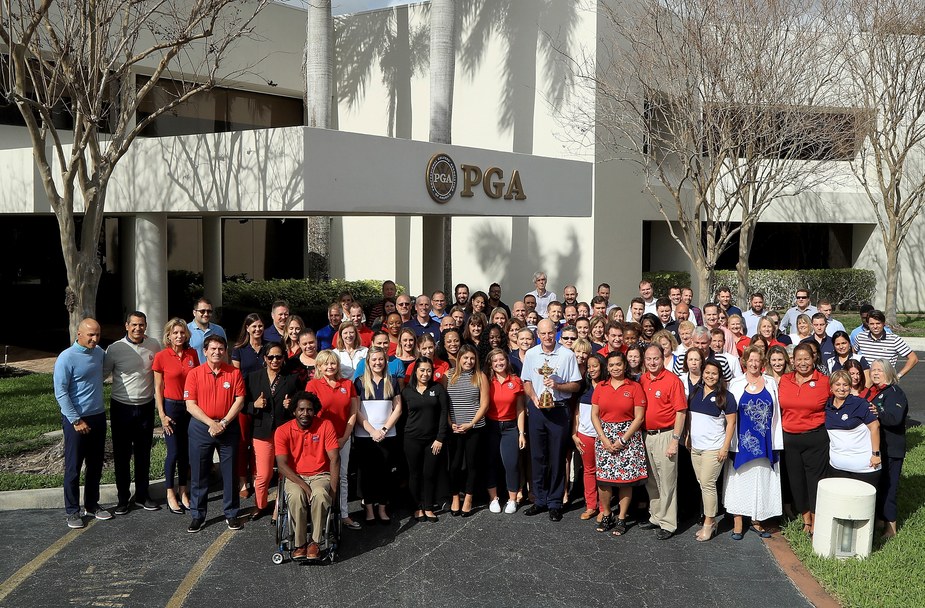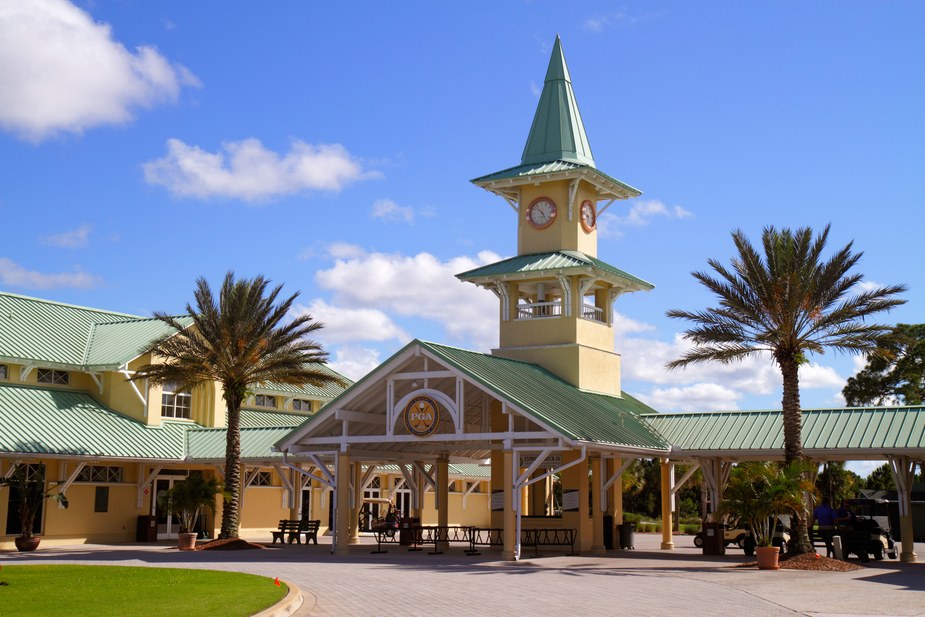The expected relocation of its headquarters, most likely to Texas, has the potential to help the association recast its image inside and outside of golf
By Dave Shedloski
Last August, while the PGA of America was revealing its plans to shift its oldest event, the PGA Championship, from August to May starting in 2019, leaders of the organization were deep in the planning stages of another move—one potentially far bigger in scope and impact.
In the coming weeks, the 100-year-old association is expected to announce that it is moving its national headquarters from its longtime home in Palm Beach Gardens, Fla., to new environs, most likely in Texas, though the location still is in doubt. A Golf.com report last month indicated that the PGA was eyeing Frisco, Texas, near Dallas, but PGA of America spokesman Julius Mason told Golf Digest that a couple of bids are under consideration, including others in South Florida.
Mason said the PGA of America would not comment about a possible move beyond a previously released statement: “Last year we issued a request for proposal to a number of markets that are potentially well suited and interested in developing a new headquarters campus for us. The due diligence phase is ongoing and no decisions have been made.”
Regardless of where the PGA of America ends up, it’s undeniable that the organization is seeking to upgrade its physical infrastructure and project a higher profile in golf—and in the sports marketplace in general.
Stated or not, part of the logic for moving the PGA Championship to May was to improve the stature of what some consider the fourth of the four men’s championships. Likewise, officials no doubt are striving to distinguish the PGA of America from the PGA Tour—still a confusing difference to many casual golf fans—as well as golf’s other major stakeholders.
It’s probably no coincidence that consideration of a move comes at a time when some of those same U.S. stakeholders—the USGA and PGA Tour as well as Augusta National Golf Club—also are making dynamic changes to their respective home bases. (Though in the case of Augusta, change, particularly expansion of its footprint, has been ongoing for years.)

Traci Edwards/PGA of America Bevacqua hasn’t been afraid to shake things up the PGA since becoming its CEO in 2012.
The move is a venturous one for PGA of America CEO Pete Bevacqua but comes at an appropriate time in his tenure with the association. Since taking over as CEO in 2012, Bevacqua has settled into a position as one of the game’s leading voices. His contract with the PGA has been extended twice already, and he is viewed by many as the best chief executive in the association’s history. He has not been afraid to consider bold actions, once talking about taking the PGA Championship overseas (an idea since tabled) before shifting the dates to May as well as working with the LPGA to facilitate the creation of the KPMG Women’s PGA Championship, and he has positioned himself and the association to take another significant step.
“Some members probably think this is just Pete looking to build his own little kingdom,” said one former PGA board member. “But the truth is, we should have done this 15 years ago. If you’re not being proactive, you’re not doing your job. Anyone who questions why we would do this isn’t looking objectively at the big picture.”
• • •
Having moved to Palm Beach Gardens in 1965, the PGA of America, with a membership of nearly 29,000 golf professionals, long ago outgrew its current facilities. According to knowledgeable sources, the PGA pays around $1 million annually to rent a second building close to the main, association-owned headquarters that houses its rules staff and other support personnel. Furthermore, the association has no control over the nearby golf courses at the resort that bears its name—PGA National.

Sam Greenwood
U.S. Ryder Cup captain Jim Furyk greeted the PGA of America staff at the association’s Palm Beach Gardens headquarters in March.
While the particulars of the offers being assembled from up to a half-dozen sites in South Florida are unknown, they would be hard-pressed to match what officials from Frisco, an upscale suburban community about 30 miles north of Dallas and close to the Dallas/Fort Worth International Airport, have reportedly put forth. In addition to a new headquarters in what is known as the Panther Creek development, the “campus” could include an office park, two new 18-hole courses, a nine-hole short course, clubhouse and an instruction academy. According to Golf.com, Gil Hanse has been retained to design one of the courses with the purpose of making it a championship-caliber layout that could host the PGA Championship or the Ryder Cup. (Reached via text, Hanse declined to comment.)
Related: The big picture on the PGA Championship’s move to May
Among the benefits of moving the PGA Championship in May was the ability to take it areas of the country that an August date makes troublesome—with a Texas often mentioned. The PGA Championship was last held in the Lone Star State in 1968 at Pecan Valley Country Club in San Antonio. The first opening for the championship is 2024, and it wouldn’t be a surprise, if the PGA filled it or one soon after with a stop at its new home. Meanwhile, Champions Golf Club in Houston hosted the lone Ryder Cup in Texas back in 1967. Domestic sites for the biennial match between the U.S. and Europe are locked up through 2032.
A PGA official with knowledge of the Frisco proposal estimates the deal is worth $30 million-$40 million for the PGA of America. Another said it might be closer to $50 million, “if everything pans out” in terms of the land and infrastructure development that are believed to comprise the bulk of the offer from Frisco. It’s also worth noting that like Florida, Texas has no state income tax and generally viewed as being business-friendly.
• • •
The response to the PGA’s request for proposal was “an eye opener,” said one longtime PGA official. More than 100 municipalities responded when the RFP was disseminated in mid-2017. “It’s obvious,” said another, “that our brand is very valuable, based on the interest the RFP generated. And whatever decision is made is going to bring more value to the brand.”
Alastair Johnston, vice chairman of IMG, agreed with the assessment of the PGA of America’s marketability. “The proof is in the pudding, obviously,” Johnston said. “If communities are willing to step forward with lucrative financial packages, they must feel that the PGA of America is well worth the investment and will be an asset to them.”
A past PGA officer, speaking on condition of anonymity, said a move is not universally popular, but believes it’s the right call, saying: “I applaud the current leadership for thinking outside the box. … This is going to make us stronger in a variety of ways. And I believe it’s a huge win for the membership.”
‘Anyone who questions why we would do this isn’t looking objectively at the big picture.’ —A past board member on moving PGA headquarters
The central question arising from a prospective address change—which could come as early as 2020—is what benefits would it bring to the thousands of club-professional members? And in turn, would those benefits impact every day golfers?
Among them is that the PGA can further separate itself from the PGA Tour, based in Ponte Vedra Beach, Fla., both geographically, and in terms of its identity. It is 50 years ago this year that tour players broke away from the PGA of America to form their own organization. But the lay sports fan often still confuses the two entities.
Johnston says the PGA of America has an inherent difference from the tour, and other golf stakeholders, that if leveraged can help in its efforts to distinguish itself. “More than any other organization, the PGA interfaces directly with the average golfer, either at a private club or a public course, at the grassroots level through its members,” Johnston said. “Commendably, this includes both male and female professionals, which is very important for a brand in this day and age.”
Shifting headquarters to the center of the country also would afford more travel convenience for officers, staff and section leaders. For a sport historically managed on the East Coast, a move west positions the association for growth. A West Coast club professional pointed out how much more direct interaction western sections could have with headquarters.
Conversely, the association will have to deal with likely turnover among PGA of America staff. One veteran club professional who did not want to be identified on the record but was familiar with the discussions, noted: “In the near term, we’re hearing about a 70 to 80 percent turnover in the staff [who would not move from Florida], which could impact member services until new personnel get through a learning curve.” Even if the rate of attrition weren’t that high, there would be a significant number of staffers who would not be making the move, and it would require the association to address how those staffers would be replaced.
Other club pros Golf Digest contacted also did not want to speak on the record, “because of the high sensitivity of the situation,” said one. “They want to get this right after some past missteps.”

Jeff Greenberg/UIG via Getty Images
The PGA of America opened PGA Golf Club in Port St. Lucie, Fla., in 1996, but the resort/training facility has struggled as a business entity.
One of those is PGA Village in Port St. Lucie, Fla., which features the PGA Golf Club, a 54-hole resort facility that opened in 1996. Despite the original two Tom Fazio courses and a third, Pete Dye design added in 1999, the project “hasn’t quite lived up to its billing” according to one source, noting that anticipated local area development never materialized. The Village also includes a 35-acre learning center, a six-hole short course. The resort, open to the public, offers PGA professionals and their guests discounts on golf, but pros often bristle at the course conditions, and it requires a subsidy of about $1.5 million annually from the association to make up for budget shortfalls. Its remote location 40 miles from PGA headquarters also is a minus.
Another club pro pointed out that the PGA “has a history of poor decisions when it comes to this very subject, though, obviously, you can’t lay any of that at the feet of people currently in charge.”
He cited the opportunity to purchase the 54-hole golf complex that is now named BallenIsles, just to the east of PGA headquarters. Built in 1964, that property constituted the original PGA National Golf Club and hosted, among other events, the 1971 PGA Championship won by Jack Nicklaus. “We’re still paying for that mistake, and then we compounded it by buying cheap land [in Port St. Lucie] that has never been the destination that it was supposed to be,” he said. “We have never really used our expertise to make it into something special.
“If their intent is to really put the money into doing something great in Dallas, then I’m all for it, but it has to be first-class all the way. We are the biggest sports organization in the world. We have $140 million in the bank. But even then, I have reservations.”
The PGA of America declined a Golf Digest request to talk to an official about member issues in relation to its relocation. One past president, however, noted, “It would be hard for me to believe our leadership hasn’t thought this through from every angle, on every issue.”
• • •
The prospect of a new 36-hole complex, plus a teaching academy all in one location (as opposed to the current setup with Port St. Lucie, which has to be used for PGA Apprentice program training), is exciting to every member who was reached for comment, especially because, said another pro, “the PGA would own it, manage it and most likely promote it in a way that would attract a lot of interest and, obviously, allow us to host our big events.”

Ross Kinnaird/Getty Images
Moving the PGA Championship to May starting in 2019 will allow the PGA of America to help re-brand the event, and by extension the association.
Which leads to the subject of optics. It’s hard not to see the PGA of America as appearing to be a more dynamic organization when, if it were to move its headquarters to Frisco, it would share a zip code with one of the NFL’s top franchises, the Dallas Cowboys, along with the NHL’s Dallas Stars and the FC Dallas soccer team of the MLS. Liberty Mutual, FedEx Office and Toyota are non-sports companies who recently have moved to North Texas, in nearby Plano. Two other companies with golf connections—AT&T and Topgolf—are also deeply connected in the metro area. Having such impressive neighbors could afford the PGA of America more commercial and economic opportunities, which could be poured into member benefits and grow-the-game initiatives.
“When you look at the social aspects, the potential business opportunities, the corporate environment there, in my mind the pros outweigh the cons,” an east coast pro said. “It’s simply a step up from what we have now—a big one.”
Added another member: “I am confident that who we have in office will make the best possible decision for everyone invested in the organization. I have no doubt about it. This is an exciting time for the PGA of America, something we can all embrace.”









